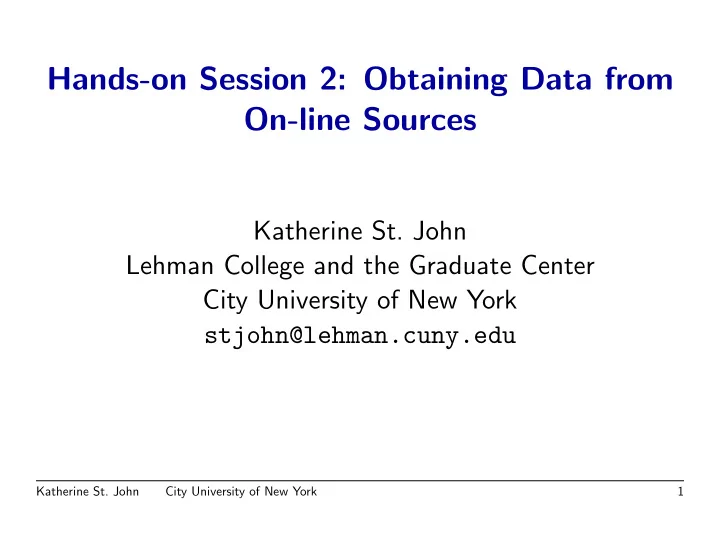

Hands-on Session 2: Obtaining Data from On-line Sources Katherine St. John Lehman College and the Graduate Center City University of New York stjohn@lehman.cuny.edu Katherine St. John City University of New York 1
Session Organization • Goal: To be comfortable building trees from real data • Lecture: – Standard Software Packages – Details on Web-based Software – Motivating Problem • Lab: – Organized so you can use the DIMACS lab, or your own laptop – Welcome to work singly or in groups Katherine St. John City University of New York 2
Lecture Outline • Motivating Problem
Lecture Outline • Motivating Problem • Building Trees Overview
Lecture Outline • Motivating Problem • Building Trees Overview • Using Sequence Databases
Lecture Outline • Motivating Problem • Building Trees Overview • Using Sequence Databases • Aligning Sequences Katherine St. John City University of New York 3
Motivating Problem: Building Trees with Serial Data? Rodrigo et al. , “Coalescent estimates of HIV-1 generation time in vivo.” PNAS ‘99 Katherine St. John City University of New York 4
Motivating Problem: Using Serial Data • Rodrigo et al. includes 55 HIV-env partial sequences, all from the same patient • Starting question: what is the genealogy samples (from the same patient) taken at different times? Katherine St. John City University of New York 5
Building Trees 1. Get data (from wet lab, authors, genBank, etc).
Building Trees 1. Get data (from wet lab, authors, genBank, etc). 2. Align and/or filter data.
Building Trees 1. Get data (from wet lab, authors, genBank, etc). 2. Align and/or filter data. 3. If needed, choose the appropriate model of evolution.
Building Trees 1. Get data (from wet lab, authors, genBank, etc). 2. Align and/or filter data. 3. If needed, choose the appropriate model of evolution. 4. Use software program(s) to build trees.
Building Trees 1. Get data (from wet lab, authors, genBank, etc). 2. Align and/or filter data. 3. If needed, choose the appropriate model of evolution. 4. Use software program(s) to build trees. 5. Analyze Results.
Building Trees 1. Get data (from wet lab, authors, genBank, etc). 2. Align and/or filter data. 3. If needed, choose the appropriate model of evolution. 4. Use software program(s) to build trees. 5. Analyze Results. We’ll focus on the first two today. Katherine St. John City University of New York 6
Using PubMed An on-line index of scientific papers: Can search by all standard methods... Katherine St. John City University of New York 7
Sequence Databases • GenBank: repository of sequences from NCBI (NIH). • As of August 2005, GenBank had 100 gigabases of sequences. • Almost all sequences from published articles are there, and can be located by their unique accession number or PubMed ID. Katherine St. John City University of New York 8
LANL HIV Databases • Los Alamos National Laboratory maintains databases of sequences, resistance, immunology, and vaccine trials. • Can be searched in numerous ways including accession number or PubMed ID. Katherine St. John City University of New York 9
Aligning Sequences • Before building a tree, the similar regions of the sequences need to be aligned.
Aligning Sequences • Before building a tree, the similar regions of the sequences need to be aligned. • One of the most common alignment programs is ClustalW: – Available via multiple servers including EBI & the Pasteur Institute – Does a global multiple sequence alignment Katherine St. John City University of New York 10
Getting Started • Find the Rodrigo et al. paper on PubMed.
Getting Started • Find the Rodrigo et al. paper on PubMed. Download the paper, and note it’s PubMed ID (PMID). • Use the PMID to find the sequences in the HIV Sequence Database.
Getting Started • Find the Rodrigo et al. paper on PubMed. Download the paper, and note it’s PubMed ID (PMID). • Use the PMID to find the sequences in the HIV Sequence Database. • Use ClustalW to align the sequences.
Getting Started • Find the Rodrigo et al. paper on PubMed. Download the paper, and note it’s PubMed ID (PMID). • Use the PMID to find the sequences in the HIV Sequence Database. • Use ClustalW to align the sequences. • Using your favorite phylogenetic reconstruction method, build a tree from the sequences.
Getting Started • Find the Rodrigo et al. paper on PubMed. Download the paper, and note it’s PubMed ID (PMID). • Use the PMID to find the sequences in the HIV Sequence Database. • Use ClustalW to align the sequences. • Using your favorite phylogenetic reconstruction method, build a tree from the sequences. • Analyze resulting trees Katherine St. John City University of New York 11
Hints: • Choose the ”fast” tree building option for ClustalW .
Hints: • Choose the ”fast” tree building option for ClustalW . • To use a distance based method, you need to create a distance matrix (dnadist) to give to the method (ie BioNJ or QuickTree ).
Hints: • Choose the ”fast” tree building option for ClustalW . • To use a distance based method, you need to create a distance matrix (dnadist) to give to the method (ie BioNJ or QuickTree ). • At the Pasteur Institute site, at each step, you can choose the next step, without reloading the file.
Hints: • Choose the ”fast” tree building option for ClustalW . • To use a distance based method, you need to create a distance matrix (dnadist) to give to the method (ie BioNJ or QuickTree ). • At the Pasteur Institute site, at each step, you can choose the next step, without reloading the file. For example, after returning the distance matrix, you have the option of applying a method to the matrix. Katherine St. John City University of New York 12
Helpful Websites • Dataset for this tutorial: http://comet.lehman.cuny.edu/stjohn/dimacsTutorial • PubMed & Genbank: http://www.ncbi.nlm.nih.gov/entrez • HIV Sequence Database: http://hiv-web.lanl.gov/content/index • The Pasteur Institute: http://bioweb.pasteur.fr/intro-uk.html Katherine St. John City University of New York 13
Recommend
More recommend